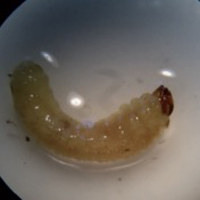Lixus algirus L. (Coleoptera: Curculionidae): biology, population fluctuation, infestation as affected by varieties, location, and planting dates in Morocco

Accepted: 13 January 2021
HTML: 33
All claims expressed in this article are solely those of the authors and do not necessarily represent those of their affiliated organizations, or those of the publisher, the editors and the reviewers. Any product that may be evaluated in this article or claim that may be made by its manufacturer is not guaranteed or endorsed by the publisher.
Authors
The stem borer, Lixus algirus L. (Coleoptera: Curculionidae) is the major insect pest of faba bean in the Mediterranean region. This study investigates the field biology and fluctuation of L. algirus at Douyet research Station in Morocco during two cropping seasons 2014-2015 and 2015-2016 using two local faba bean varieties. The influence of sowing dates and varieties on the damage caused by L. algirus was investigated over different locations and seasons using a split-plot design. The overwintering adults appear in the field from February by feeding over the leaves of faba bean plants. Eggs are laid from Mid-February through late April and mostly during March. The egg peak ranged from 0.75 to 1.1 eggs per plant. The number of larvae increases during March and peaked in April. The larval peaks ranged between 0.45 to 1.5 larvae per plant. The larval development takes an average of 42 days. Pupation lasts about 21 days within stems. Adults emerged in early June. Life cycle duration was 80 days. One generation of L. algirus was recorded on faba bean varieties in Morocco. The mean number of eggs showed a positive correlation with total rainfall. The number of pupae and relative humidity was negatively correlated. Peach and almond leaves were the most preferred by the newely emerged L. algirus adult during the summer and early autumn period. Planting dates did not affect L. algirus infestation levels over all varieties tested and locations.
Supporting Agencies
This research was partially funded by the project “India-Morocco Food Legumes Initiative – Morocco Component OCP Foundation, ID: 100161”.How to Cite
PAGEPress has chosen to apply the Creative Commons Attribution NonCommercial 4.0 International License (CC BY-NC 4.0) to all manuscripts to be published.

 https://doi.org/10.4081/jear.2021.9324
https://doi.org/10.4081/jear.2021.9324



